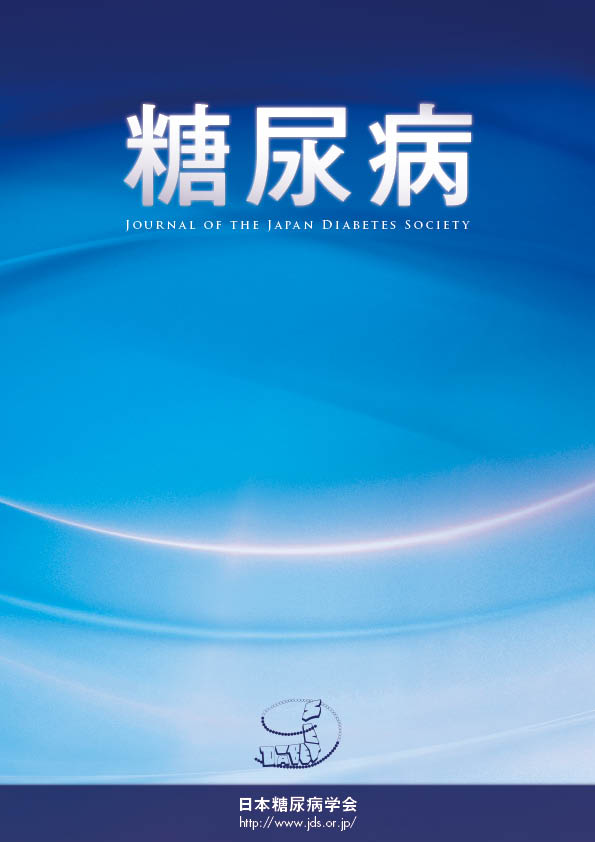
- Issue 4 Pages 173-
- Issue 3 Pages 129-
- Issue 2 Pages 43-
- Issue 1 Pages 1-
- |<
- <
- 1
- >
- >|
-
Shin Kawanabe, Tomoko Nakagawa, Shutarou Uchiyama, Yuta Nakamura, Hide ...2024 Volume 67 Issue 4 Pages 173-180
Published: April 30, 2024
Released on J-STAGE: April 30, 2024
JOURNAL RESTRICTED ACCESSA 71-year-old woman with recurrent esophageal cancer was treated with nivolumab. For the early detection of type 1 diabetes caused by immune-related adverse events (irAEs), the patient was instructed to self-measure urinary glucose levels at the start of drug therapy. After 22 courses of treatment, the patient tested positive for urinary glucose and presented to our hospital with fatigue. Laboratory investigations revealed hyperglycemia (blood glucose, 352 mg/dL); however, her glycosylated hemoglobin (HbA1c) level was relatively low at 6.6 %, with no urinary ketones or acidosis. Due to her rapidly rising blood glucose levels, we suspected the development of type 1 diabetes mellitus caused by nivolumab and initiated insulin therapy. Subsequently, the chemotherapy regimen was changed; however, the patient was hospitalized because of diabetic ketoacidosis. Therefore, the patient was diagnosed with type 1 diabetes caused by irAEs due to low C-peptide levels in her blood and urine. At our hospital, we instruct patients to self-monitor their urine glucose levels when they were being treated with immune checkpoint inhibitors. This guidance may help to detect the onset of type 1 diabetes at an early stage and prevent the development severe disease.
View full abstractDownload PDF (1397K) -
Reiko Homma, Takahisa Iida, Takanori Miura, Akihiro Fujinaga, Kazuhide ...2024 Volume 67 Issue 4 Pages 181-188
Published: April 30, 2024
Released on J-STAGE: April 30, 2024
JOURNAL RESTRICTED ACCESSWe present the case of a 56-year-old man with type2 diabetes who experienced frequent episodes of hypoglycemia despite discontinuing antidiabetic medication while being admitted to our cardiology department for coronary artery stenting. The patient was diagnosed with hyperinsulinemic hypoglycemia based on the findings of various tests (fasting blood glucose 36 mg/dL, insulin level 64.3 μU/mL, CPR level 13.3 ng/mL), and further investigations were conducted. Abdominal ultrasonography, CT, and MRI did not reveal any pancreatic tumors. Owing to the difficulty of performing invasive tests immediately after coronary stent placement, the patient was treated with diazoxide. However, the hypoglycemic episodes persisted and increased with the increasing doses of diazoxide. A Selective Arterial Calcium Injection (SACI) test showed positive findings, thus leading to the patient's decision to undergo surgery. A pathological examination confirmed hyperplasia of the pancreatic islet cells corresponding to the positive SACI test site, thereby leading to a diagnosis of nesidioblastosis. While the occurrence of nesidioblastosis in a patient with type2 diabetes is rare, in cases where no evident pancreatic tumors are present, we should consider the possibility of nesidioblastosis and carefully select the optimal surgical and treatment approaches.
View full abstractDownload PDF (917K)
-
2024 Volume 67 Issue 4 Pages 189-201
Published: April 30, 2024
Released on J-STAGE: April 30, 2024
JOURNAL RESTRICTED ACCESSDownload PDF (760K)
-
Committee of Pediatric Diabetes in the Japan Diabetes Society, Tatsuhi ...2024 Volume 67 Issue 4 Pages 202-208
Published: April 30, 2024
Released on J-STAGE: April 30, 2024
JOURNAL RESTRICTED ACCESSA questionnaire survey on severe hypoglycemia (SH) in pediatric patients with diabetes was distributed to pediatric diabetes specialists and members of the Committee of Pediatric Diabetes in the Japan Diabetes Society. Twenty-five patients under 15 years old in 11 hospitals experienced SH from January 2017 to December 2021. SH most frequently occurred in patients 10-15 years old and between 0:00 and 08:00 a.m. The majority of the patients had SH at home during the nighttime. Only four patients experienced SH during school hours. Eleven patients took glucose orally, while five used glucagon nasal powder. Fifteen patients were transferred to hospital emergency units for the management of SH. Based on these results, the frequency of SH was estimated to be 0.01/patient/year, and the treatment for SH seemed insufficient.
View full abstractDownload PDF (359K)
-
2024 Volume 67 Issue 4 Pages e106-e128
Published: April 30, 2024
Released on J-STAGE: April 30, 2024
JOURNAL RESTRICTED ACCESSDownload PDF (154K)
- |<
- <
- 1
- >
- >|